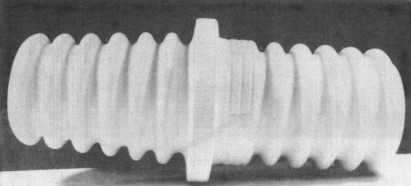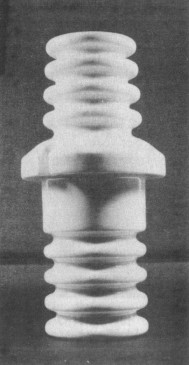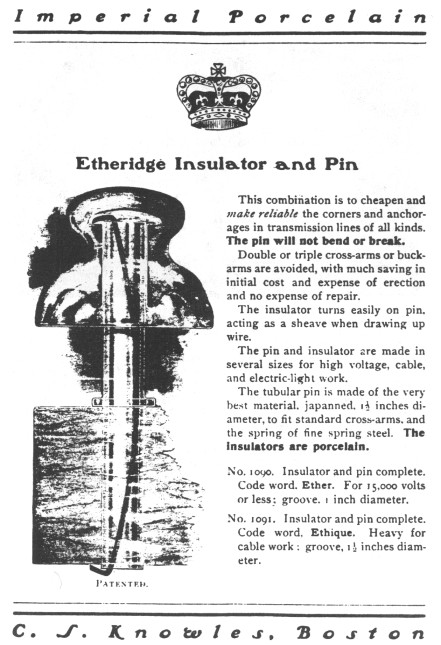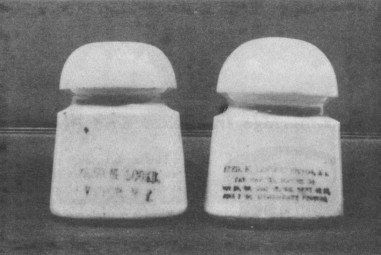Porcelain Insulator News
by Elton Gish, NIA #41
Reprinted from "INSULATORS - Crown Jewels of the Wire", August 1984, page 24
The Imperial bushing pictured
below was first reported in this column April, 1981 on page 22. It is 12"
long and is incuse marked on the wide center ring: IMPERIAL 116597
There is a
second Imperial bushing known (pictured 2nd) that is much smaller. It is
5-5/8" long and has an incuse marking below the wide central ring:
IMPERIAL
38922


Little is known about Imperial history. We only know about their pin types
because of the many styles that exist with Imperial markings. Specimen evidence
indicates that Imperial got out of the pin types about 1904, as the latest known
date is 3-17-04. This date was found on a brown sim U-710. They could have
likewise stopped production at that time of other HV types such as these
bushings. The company continued to make porcelain items, including wiring
insulators for many years until about the time of the depression. We never have
been able to get any direct info (catalogs, etc.) on Imperial, only material
indirectly from other sources, other jobber catalogs, etc. The door is wide open
to anyone with the time to go to Trenton, New Jersey, to research old city
directories, etc., to learn more about this early company.
Several years ago,
Ray Klingensmith sent me this copy of a page from a C. S. Knowles catalog.
Knowles was a jobber of Imperial pin types. The illustration is of a U-376A
Etheridge insulator and pin assembly made by Imperial Porcelain.

Large Image (239 Kb) |
(text from image)
Imperial
Porcelain
Etheridge Insulator and Pin
This combination is to cheapen and make
reliable the corners and anchorages in transmission lines of all kinds. The pin
will not bond or break.
Double or triple cross-arms or buck-arms are avoided,
with much saving in initial cost and expense of erection and no expense of
repair.
The insulator turns easily on pin. Acting as a sheave when drawing up
wire.
The pin and insulator are made in several sizes for high voltage, cable,
and electric-light work.
The tubular pin is made of the very best material.
japanned. 1-1/2" inches diameter, to fit standard cross-arms. and the
spring of fine spring steel. The Insulators are porcelain.
No. 1090. Insulator
and pin complete. Code word. Ether. For 15,000 volts or less.; groove. 1 inch
diameter.
No. 1091. Insulator and pin complete. Code word, Ethique. Heavy for
cable work: groove, 1-1/2" inches diameter.
|
The next photo is of two U-3's
with Fred Locke markings 0-5 AN6 6-3. These are underglaze markings in green
ink. Underglaze markings on Fred Locke Pony insulators are very rare, if not
unique. These were first cataloged by Locke in 1899 as the No. 6 Pony. The No. 6
Pony was changed to U-38 in 1902. Locke catalogs have not been found for
1903-1906, but Ohio-Brass was a selling agent of "Victor" insulators
and listed the U-3 in their 1905 catalog as the "Victor" Pony No. 9.
It was listed as such in Locke catalogs for many years after that.

The photo is
also a good example of the many variations found in Fred Locke insulators of the
same U-#. The position, shape and depth of the wire groove added by green
trimming is not a constant. The overall insulator body is pressed in a hollow
cavity (no groove) and, after the damp insulator has been "cured" a
day, it is mounted on a spindle operated by a foot-switch and spun, the side
groove being trimmed in with a cutter swung over against the spinning insulator.
For something as simple as the U-3, the whole trimming cycle for the operator
would be less than five seconds -- about ten or more trimmed per minute. Groove
height would depend on how the insulator seated on the spindle, how the trimmer
was set up, how sloppy the arm was hinged, etc. Depth is controlled only by
operator eye in that split second it takes to do it. Groove shape is just how
the trimmer blade was shaped. They look like pieces of scrap "tin",
but are probably made of something better that will take a temper as old hacksaw
blades or any type of spring steel strip. Thus, unless obviously meant to be
different in a gross way, we can't consider these variations as different
"styles" and assign them different U-#'s.
|
